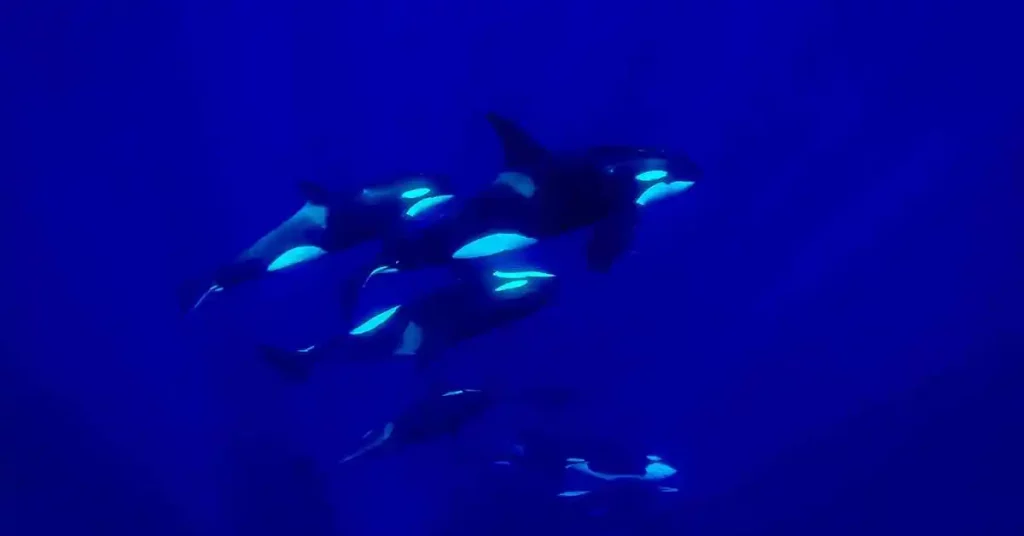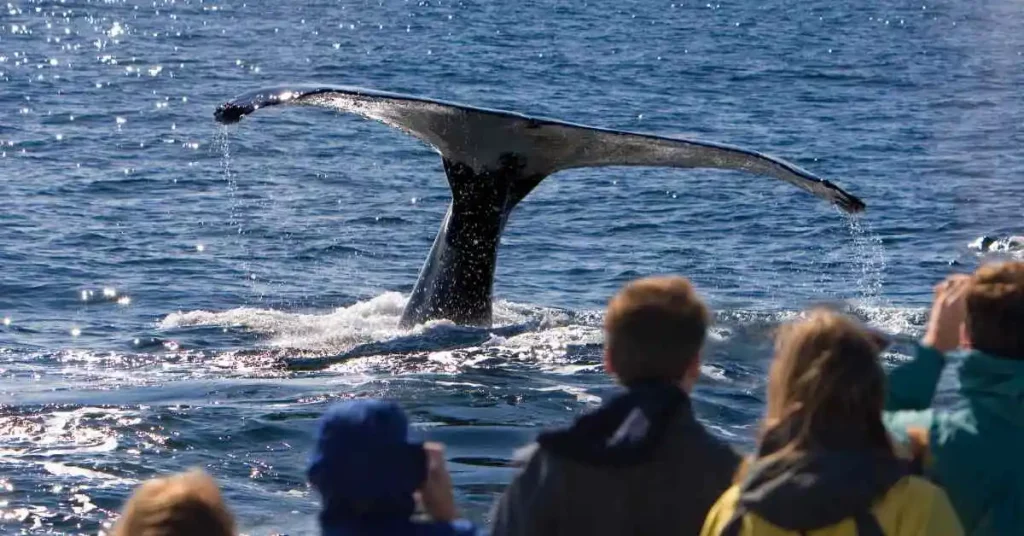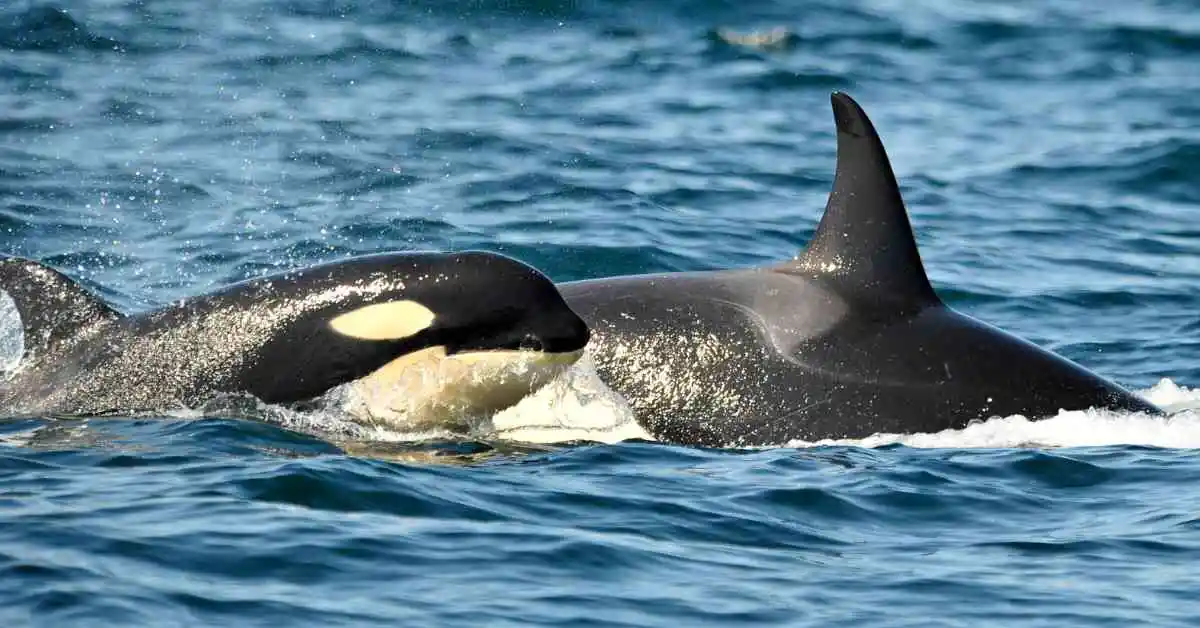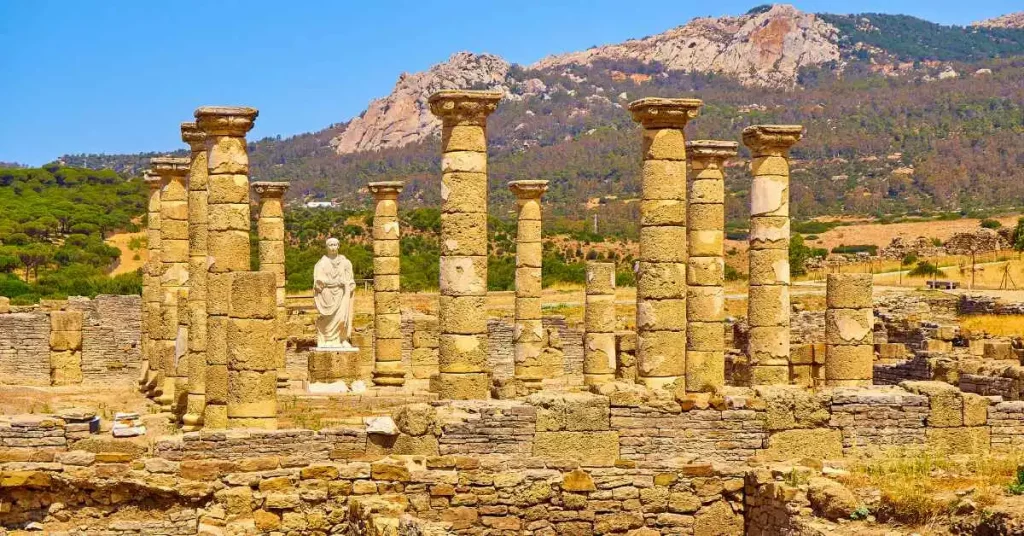If you’re wondering when to see orcas in Tarifa, the short answer is: during the peak migration period for bluefin tuna through the Strait, in the middle of summer. The long answer: the probability varies depending on the wind, tides and, above all, the movement of bluefin tuna, the main prey of the Iberian subpopulation of orcas. For this reason, many local companies concentrate their specific orca trips in the peak months of migration, when it is most likely to see them.
Iberian orcas form a very small and unique population that moves between the Gulf of Cádiz, the Strait and the Iberian Atlantic coast following the bluefin tuna. This subpopulation is classified as Critically Endangered (IUCN) and consists of approximately 40 individuals, hence the importance of responsible sightings and choosing operators that comply with good practices.
Even so, we are talking about wildlife: there are no absolute guarantees. Success improves significantly if you book several days in a row, ideally with morning departures, when sea conditions are usually more favourable and the orcas’ hunting activity is more intense.
In the following sections, we will tell you what orcas are, their habits and longevity; where to see orcas in the wild inside and outside Spain; and, above all, when to go whale watching in Tarifa with the greatest chance of success. If you are interested in whale watching, be sure to book your accommodation in Tarifa in advance, as most sightings occur during the high tourist season and options sell out quickly.
What are orcas and why are they so special?
The orca (Orcinus orca) is the largest dolphin on the planet, a marine superpredator with complex matriarchal societies and distinct feeding cultures depending on the population. Popularly known as ‘killer whales’ (a mistranslation of the English ‘killer whale’), they actually belong to the oceanic dolphin family.
Globally, the IUCN does not have sufficient data to make a general assessment of the species’ status. This is due to variation between ecotypes and the difficulty of conducting accurate censuses. However, several local populations are threatened, such as the Iberian population, which faces critical risks to its survival.
Physical and social characteristics
Orcas are highly intelligent animals with sophisticated communication systems. Each population has its own dialects and hunting techniques that are passed down culturally from generation to generation. Males can reach 8-9 metres in length and weigh up to 6 tonnes, while females are smaller, reaching 7-8 metres.
They live in stable family groups led by matriarchal females. Social bonds are so strong that individuals rarely leave their natal group, staying together for their entire lives.
What do orcas eat?
Their diet varies dramatically depending on their ecotype and geographical location. In the Strait of Gibraltar, Iberian orcas
Other orca populations hunt seals, sea lions, sharks, rays, smaller fish and even other whales. This dietary diversity reflects their extraordinary ability to adapt and learn.

How long do orcas live?
Orcas have a remarkable life expectancy, which varies according to sex. Males typically live between 30 and 60 years, with an average of 50 years. Females, however, have exceptional longevity: they can live between 50 and 90 years, and some studies suggest that they occasionally exceed a century of life.
Females go through menopause, an extremely rare phenomenon in the animal kingdom (shared only with humans, pilot whales, and belugas), which allows older matriarchs to play a crucial role in the transmission of knowledge and the survival of the group.
How many orcas are left in the world?
There is no definitive global census, and the IUCN maintains the classification of ‘Insufficient Data’ for the species in general. Some scientific estimates put the global population at around 50,000 individuals, although these figures should be treated with caution due to methodological difficulties.
What is truly relevant for the Strait of Gibraltar is that the Iberian population is minimal (≈40 identified individuals) and is considered a conservation priority at the European level. Every orca literally counts.
Where can you see orcas in the wild?
If your dream is to see orcas in their natural habitat, these are the world’s top destinations, each with its own optimal season:
Europe
- Tarifa and the Strait of Gibraltar (Spain): The best option on the Iberian Peninsula. Peak season linked to bluefin tuna in July and August. Several companies offer specialised 3-hour trips specifically focused on searching for them.
- Tromsø and Skjervøy (Norway): Season from late October to January, coinciding with the return of herring to the Norwegian fjords. Spectacular Arctic landscapes with the possibility of seeing the Northern Lights.
- Snæfellsnes Peninsula – Ólafsvík (Iceland): Optimal window from late winter to spring (March-June). Orcas follow herring shoals through Icelandic waters.
America
- Johnstone Strait – Vancouver Island (Canada): Summer-early autumn season (July-September). Resident killer whales in the North Pacific follow the salmon on their migration.
- Peninsula Valdés (Argentina): One of the most impressive spectacles on the planet. Orcas intentionally beach themselves (March-April, at high tide) to hunt sea lions on the shore. This unique technique is taught from mother to calf.
- San Juan Islands (Washington, USA): Sightings from May to September. Three well-studied and documented resident pods.
Oceania
- New Zealand (Hauraki Gulf and Kaikoura): Sightings throughout the year. New Zealand orcas specialise in rays and sharks, including the great white shark.
- Bremer Bay (Western Australia): One of the largest congregations of orcas on the planet during January-April, feeding in the underwater canyon.
Where can you find orcas in Spain?
As we have already mentioned, in Spain, orcas are mainly concentrated in the Gulf of Cádiz and the Strait of Gibraltar, moving according to the migratory patterns of bluefin tuna. This small population travels between Spanish, Portuguese and Moroccan waters following their prey.
In recent years (especially since 2020), unusual interactions with boats have been recorded along the entire Iberian Atlantic coast, including Galicia and the Cantabrian coast. These encounters have led to the implementation of specific seasonal navigation protocols to protect both orcas and sailors.
The phenomenon of interactions
Interactions with boats, mainly involving juvenile orcas, have generated concern and scientific debate. Experts suggest that this could be socially learned behaviour, possibly initiated after a traumatic event involving a boat. The Spanish and Portuguese maritime authorities maintain updated protocols for these encounters.
If you go out to sea in a private boat, always consult the official recommendations, stop the engine if you encounter orcas, and avoid any kind of active approach. Cetacean watching is regulated by law to ensure their welfare.
When is the best time to go whale watching in Tarifa?
The best time to maximise your chances of seeing orcas in Tarifa is July and August, coinciding with the peak of the bluefin tuna migration through the Strait of Gibraltar. During these weeks, specialist operators schedule specific orca watching trips, usually in the morning (normally between 8:00 and 9:00 a.m.) and lasting approximately 3 hours.
Factors influencing sightings
- Wind: The Levante (easterly wind) can complicate trips and reduce visibility at sea. Days with Poniente (westerly wind) or calm conditions are usually more favourable.
- Tides: The currents in the Strait vary according to the phases of the moon and can influence the movement of tuna.
- Bluefin tuna activity: Orcas follow their prey. If there is good tuna activity, there is a greater chance of locating orcas.
Recommendations for increasing your chances of success
- Book multiple days: The most effective approach is to book 2-3 consecutive days of trips to compensate for the unpredictability of wildlife. If conditions are not ideal on one day or the orcas do not appear, you will have more opportunities.
- Flexibility of dates: If you can choose, check with the operators which days have reported the most sightings recently. Some companies keep daily records.
- Morning trips: The early hours of the day usually offer better sea conditions (less swell and wind) and greater hunting activity by the orcas.

What happens if there are no orcas?
Reputable operators adjust schedules and routes based on the previous day’s records and communications between boats. If no orcas are located, the trips are dedicated to searching for other species commonly found in the Strait:
- Bottlenose dolphin (Tursiops truncatus): Sightings almost guaranteed
- Common dolphin (Delphinus delphis): Very common in large groups
- Long-finned pilot whale (Globicephala melas): Common all year round
- Sperm whale (Physeter macrocephalus): Occasional, more common in summer
- Fin whale (Balaenoptera physalus): Second largest mammal on the planet, present in the Strait
Choose a responsible operator
It is essential to select companies that are committed to conservation and strictly comply with:
- Codes of conduct for whale watching
- Informative briefings prior to boarding
- Minimum safety distances
- Limitation of observation time per group
- Specific training for skippers and guides
- Collaboration with scientific photo-identification projects
Companies such as FIRMM and Turmares actively work with researchers and maintain rigorous protocols for responsible sightings..
La Residencia Apartments: Enjoy a getaway to Tarifa
To enjoy the Strait experience in total comfort, stay at Apartamentos La Residencia. Our location is unbeatable: you are just a few steps from the historic centre of Tarifa and less than a 10-minute walk from the port, where all the orca watching excursions depart from.
Why choose La Residencia?
- Strategic location: Leaving early for the orca excursion is essential. From our apartments, you can reach the port with a comfortable morning walk, without having to get up too early or worry about parking.
- Spacious and well-equipped: After an exciting day at sea, there’s nothing like relaxing in apartments with fully equipped kitchens, spacious living areas and all the amenities you need for a comfortable stay.
- Premium facilities: Heated infinity pool, sauna, terrace with views of Africa and barbecue area. The perfect place to rest between trips or enjoy days off if the wind makes sailing difficult.
- Connectivity: High-speed Wi-Fi in all apartments, ideal for sharing your sightings on social media or working remotely if you are combining holidays with teleworking.
- Pet-friendly: If you are travelling with your dog, we have options designed for families who do not want to leave their furry companions at home.




